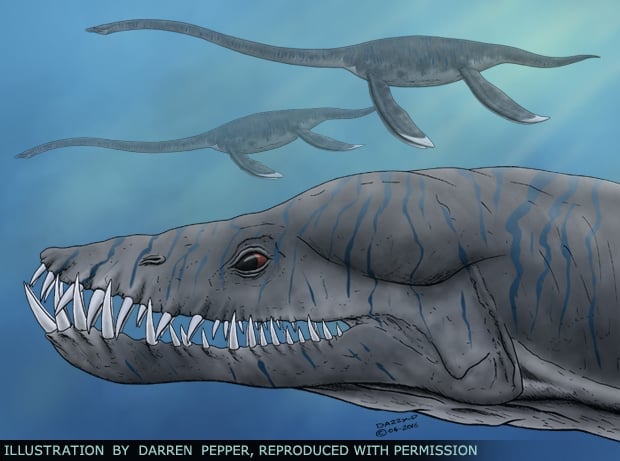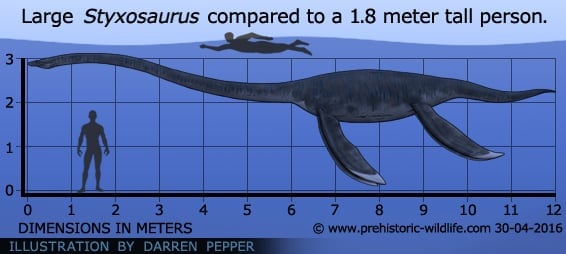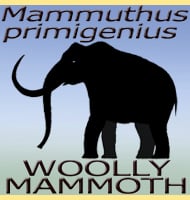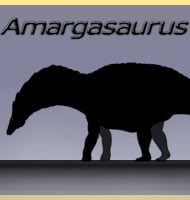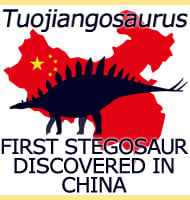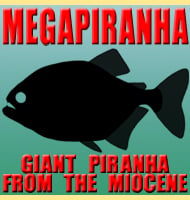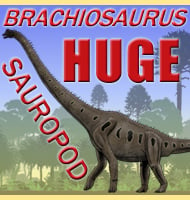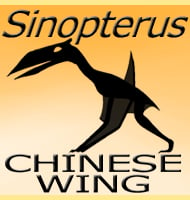In Depth
The first specimen of Styxosaurus was of a skull and twenty cervical (neck) vertebrae, but was initially described as a species of Cimoliasaurus (C. snowii) by Samuel Wendell Williston in 1890. Williston then shifted it over as a species of Elasmosaurus in 1906 as E. snowii. Later study by Samuel Paul Welles led to the material being used to create the new genus of Styxosaurus, naming it after the river that in Greek Mythology separated the underworld from the land of the living. A second and more complete elasmosaurid skeleton was described by Welles and James Bump as a new species Alzadasaurus pembertoni in 1949. However later study by Ken carpenter in 1999 found that it was actually another specimen of Styxosaurus. The transferal of fossil material has not always been towards Styxosaurus however, as a second species named S. browni (named by Welles in 1952) was later found to be a specimen of Hydralmosaurus. Like other elamosaurid plesiosaurs Styxosaurus had a very long neck that accounted for up to half its body length. This neck is thought to have been the primary feeding adaptation which allowed Styxosaurus to reach into shoals of fish. An increasingly popular theory is that elasmosaurids like Styxosaurus may have approached fish from beneath so that they could use the murk of deeper waters to hide their bodies while they presented a small profile of the front of the head to the prey. Such behaviour would greatly reduce the chance of being spotted by the prey that Styxosaurus was stalking, increasing the chance of a successful hunt. Styxosaurus also had the typical sharp thin teeth that intermeshed together when the jaws closed so that there was absolutely no escape for any fish caught between them.
Like many other marine reptiles like it, Styxosaurus has been found with a large number of gastrolith stones within its body. The swallowing of stones by plesiosaurs has long been interpreted as an attempt to counter the lifting effect of the air in the lungs so that the individual could swim more easily below the surface. Today though things are not so clear cut as this Styxosaurus specimen actually has fish bones which look like they have been ground by the stones. This fits in with the type of teeth in the mouth of Styxosaurus which are perfectly adapted for seizing fast and slippery prey, but next to useless for cutting through flesh. This means that after prey was swallowed whole, the stones would rub off things like scales so that the flesh could be digested as well as the remaining bones being ground and broken up. Additionally the weight of the gastroliths when measured resulted in a combined weight that was but a tiny fraction of the total weight of the living animal. With this in mind it seems reasonable that the primary function of the gastroliths in Styxosaurus and other plesiosaurs was to help with digestion, while any additional effect of the stones providing increased ballast was more of a secondary benefit.
Though predatory, Styxosaurus, especially smaller juveniles would have been vulnerable to larger sharks such as Cretoxyrhina and Cardabiodon, while the emerging mosasaurs would become the top predators of the seas, and even threaten adult Styxosaurus.
Further Reading
– Structure of the Plesiosaurian Skull. – Science 16 (405): 262. – S. W. Williston – 1890a. – North American plesiosaurs: Elasmosaurus, Cimoliasaurus, and Polycotylus. – American Journal of Science Series 4 21: 221–236. – S. W. Williston – 1906. – Elasmosaurid plesiosaurs with description of new material from California and Colorado. – Memoirs of the University of California 13:125-254. – S. P. Welles – 1943. – Revision of North American elasmosaurs from the Cretaceous of the western interior. – Paludicola 2(2):148-173. – K. Carpenter – 1999. – Gastroliths associated with plesiosaur remains in the Sharon Springs Member of the Pierre Shale (Late Cretaceous), western Kansas. – Transactions of the Kansas Academy of Science 103(1-2): 58-69. – M. J. Everhart – 2000. – Taxonomic reassessment of Hydralmosaurus as Styxosaurus: new insights on the elasmosaurid neck evolution throughout the Cretaceous. – PeerJ 4:e1777. – R. A. Otero – 2016.
